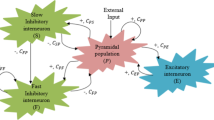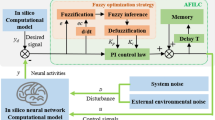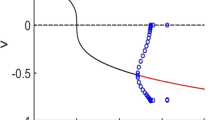Abstract
In this paper, the problem of controlling epileptiform spikes in a neural mass model is addressed. Considering the complication and nonlinearity of the neural mass model, a fuzzy PID controller is designed so that epileptiform spikes are quenched and the output waveform tracks an expected one. The tracking effect is analyzed by numerical simulation for a regular network of coupled neural populations. The effect of important model parameters on the control energy and the effect of the types of controlled populations on the ability to realize the tracking purpose are analyzed for the same network.










Similar content being viewed by others
References
Nunez, P.L.: Electric Fields of the Brain. Oxford University Press, New York (1981)
David, O., Friston, K.J.: A neural mass model for MEG/EEG: coupling and neuronal dynamics. NeuroImage 20, 1743–1755 (2003)
Hodgkin, A.L., Huxley, A.F.: A quantitatived description of membrane current and its application to conduction and excitation in nerve. J. Physiol. 117, 500–544 (1952)
Ding, L., Hou, C.: Stabilizing control of Hopf bifurcation in the Hodgkin–Huxley model via washout filter with linear control term. Nonlinear Dyn. 60, 131–139 (2010)
Shirahata, T.: The effect of variations in sodium conductances on pacemaking in a dopaminergic retinal neuron model. Acta Biol. Hung. 62, 211–214 (2011)
Lopes da Silva, F.H., van Rotterdam, A., Barts, P., et al.: Models of neuronal populations: the basic mechanisms of rhythmicity. Prog. Brain Res. 45, 281–308 (1976)
Jansen, B.H., Zouridakis, G., Brandt, M.E.: A neurophysiologically-based mathematical model of flash visual evoked potentials. Biol. Cybern. 68, 275–283 (1993)
Jansen, B.H., Rit, V.G.: Electroencephalogram and visual evoked potential generation in a mathematical model of coupled cortical columns. Biol. Cybern. 73, 357–366 (1995)
Zavaglia, M., Cona, F., Ursino, M.: A neural mass model to simulate different rhythms in a cortical region. Comput. Intell. Neurosci. 10, 1155–1158 (2010)
Cona, F., Zavaglia, M., Massimini, M., Rosanova, M., Ursino, M.: A neural mass model of interconnected regions simulates rhythm propagation observed via TMS-EEG. NeuroImage 57(3), 1045–1058 (2011)
David, O., Kiebel, S.J., Harrison, L.M., et al.: Dynamic causal modeling of evoked responses in EEG and MEG. NeuroImage 30, 1255–1272 (2006)
David, O., James, M.K., Friston, K.J.: Mechanisms of evoked and induced responses in MEG/EEG. NeuroImage 31, 1580–1591 (2006)
Lytton, W.W.: Computer modelling of epilepsy. Nature 9, 626–637 (2008)
Van Albada, S.J., Robinson, P.A.: Mean-field modeling of the basal ganglia-thalamocortical system. I: Firing rates in healthy and Parkinsonian states. J. Theor. Biol. 257, 642–663 (2009)
Van Albada, S.J., Gray, R.T., Drysdale, P.M., Robinson, P.A.: Mean-field modeling of the basal ganglia-thalamocortical system. II: Dynamics of Parkinsonian oscillations. J. Theor. Biol. 257, 664–688 (2009)
Rubchinsky, L.L., Park, C., Worth, R.M.: Intermittent neural synchronization in Parkinson’s disease. Nonlinear Dyn. 3, 329–346 (2012)
Bhattacharya, B.S., Coyle, D., Maguire, L.P.: A thalamo-cortico-thalamic neural mass model to study alpha rhythms in Alzheimer’s disease. Neural Netw. 24(6), 631–645 (2011)
Wendling, F., Bellanger, J.J., Bartolomei, F., et al.: Relevance of nonlinear lumped-parameter models in the analysis of depth-EEG epileptic signals. Biol. Cybern. 83, 367–378 (2000)
Goodfellow, M., Schindler, K., Baier, G.: Intermittent spike-wave dynamics in a heterogeneous, spatially extended neural mass model. NeuroImage 55, 920–932 (2011)
Goodfellow, M., Schindler, K., Baier, G.: Self-organised transients in a neural mass model of epileptogenic tissue dynamics. NeuroImage 59, 2644–2660 (2012)
Krauss, G.L., Cerebellar, K.MZ.: Thalamic stimulation treatment for epilepsy. Acta Neurochir., Suppl. 97, 347–356 (2007)
Pollo, C., Rationale, V.JG.: Mechanisms of efficacy, anatomical targets and future prospects of electrical deep brain stimulation for epilepsy. Acta Neurochir., Suppl. 97, 311–320 (2007)
Benabid, A.L.: What the future holds for deep brain stimulation. Expert. Rev. Med. Devices 4, 895–903 (2007)
Sunderam, S., Gluckman, B., Reato, D., Bikson, M.: Toward rational design of electrical stimulation strategies for epilepsy control. Epilepsy Behav. 17, 6–22 (2010)
Ivancevic, T., Jain, L., Pattison, J., Hariz, A.: Nonlinear dynamics and chaos methods in neurodynamics and complex data analysis. Nonlinear Dyn. 56, 23–44 (2009)
Passino, K.M., Yurkovich, S.: Fuzzy Control. Tsinghua University Press, Bejing (2001)
Kovacic, Z., Bogdan, S.: Fuzzy Controller Design Theory and Applications. China Machine Press, Beijing (2010)
Khosravi, S., Jahangir, M., Afkhami, H.: Adaptive fuzzy SMC-based formation design for swarm of unknown time-delayed robots. Nonlinear Dyn. 4, 1825–1835 (2012)
Ren, C., Tong, S., Li, Y.: Fuzzy adaptive high-gain-based observer backstepping control for SISO nonlinear systems with dynamical uncertainties. Nonlinear Dyn. 2, 941–955 (2012)
Lin, C.C., Liu, W.C., Chan, C.C., Ju, M.S.: Fuzzy control with amplitude/pulse-width modulation of nerve electrical stimulation for muscle force control. J. Neural Eng. 9, 026026 (2012)
Guclu, R., Yazici, H.: Seismic-vibration mitigation of a nonlinear structural system with an ATMD through a fuzzy PID controller. Nonlinear Dyn. 3, 553–564 (2009)
Cetin, S., Akkaya, A.V.: Simulation and hybrid fuzzy-PID control for positioning of a hydraulic system. Nonlinear Dyn. 3, 465–476 (2010)
Acknowledgements
This research was supported by National Natural Science Foundation of China (61004050, 61273260, 61172095) and Specialized Research Fund for the Doctoral Program of Higher Education (20101333110006).
Author information
Authors and Affiliations
Corresponding author
Rights and permissions
About this article
Cite this article
Liu, X., Liu, H., Tang, Y. et al. Fuzzy PID control of epileptiform spikes in a neural mass model. Nonlinear Dyn 71, 13–23 (2013). https://doi.org/10.1007/s11071-012-0638-1
Received:
Accepted:
Published:
Issue Date:
DOI: https://doi.org/10.1007/s11071-012-0638-1




